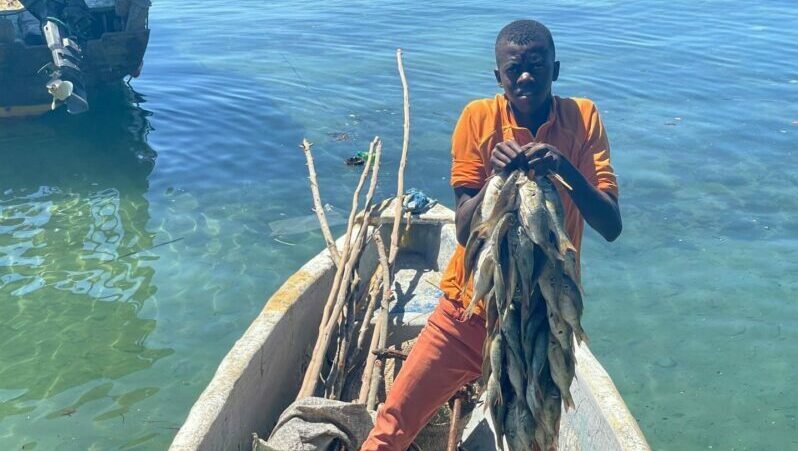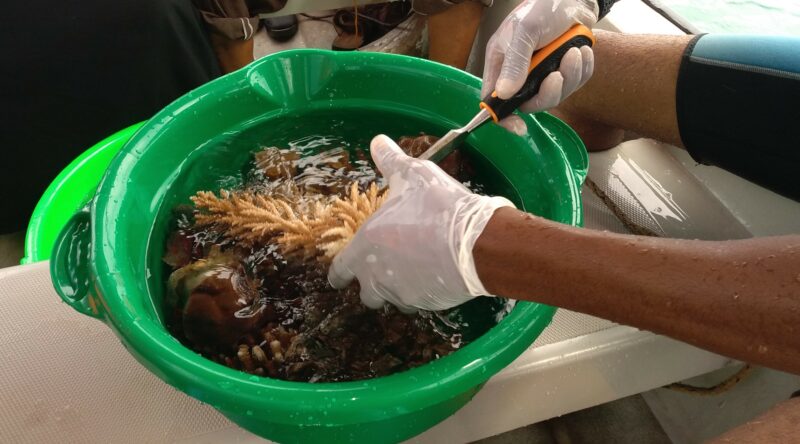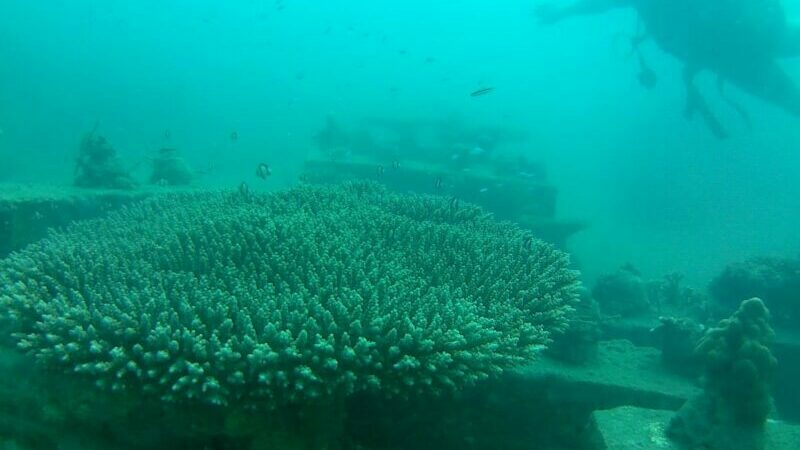Five years ago, 20-year-old Said Abdallah was struggling with alcohol and drug addiction while living on Wasini Island, located in the Indian Ocean, 3 kilometres off Kenya’s southeast coast.
“I did not have a job, so my best hours were spent with a group of other young fellows like me. I was constantly worried on how best I could improve my life. Sometimes, getting high would calm those thoughts,” Abdallah told Climate Home News.
“I needed means to get a job. The island has limited sources of livelihood: it’s either you are in tourism or fishing. But in all you need someone to guide [you],” Abdallah said.
Struggling to find work, Abdallah approached a local conservation group working to restore degraded coral reefs along the Wasini shoreline.
The Wasini Beach Management Unit (BMU) is a 600-member group rehabilitating corals and seagrass located along the Shimoni-Vanga seascape which borders Tanzania. Rising sea temperatures have bleached the corals and destroyed vital marine habitats, which are home to endangered species like dugongs and turtles.
The BMU hired Abdallah as a diver, to work as part of a team removing plastic waste, sand and other debris from the reefs and seagrass, and transplanting healthy coral fragments into the ocean.

A Wasini BMU diver attaches a coral fragment to an artifical reef made from cement. (Photo: Coastal Development Authority)
Community conservation
Kenya’s marine and fisheries research institute (KMFRI) launched the project in 2014 with the aim of mobilising the islanders to restore their marine environment, which has never been the same since the first recorded global coral bleaching event in 1998.
“Before the 1998 global coral reefs mass bleaching, coral cover along the Kenyan shoreline was about 40%. After the El Niño impact, Kenya lost at least half of its cover,” Dr Jelvas Mwaura, a coral reef scientist at KMFRI, told Climate Home News.
In addition to the mass bleaching, Wasini BMU chair Muhidin Musa told Climate Home News that fishers in Wasini and surrounding villages used unsustainable fishing methods which had killed corals and withered the seagrass. Lobsters disappeared and fish catch reduced along the Shimoni-Vanga seascape. By 2004 fishing around Wasini was nearly impossible, said Musa.
“The sea is our farm: we depend on fishing and tourism for sustenance. So, our major challenge was restoring the fish biomass, which had gone down. If replanting corals and seagrass would bring back life, then the village was ready to go to work,” said Musa.
According to the National Oceanic and Atmospheric Administration (NOAA), around 25% of the ocean’s fish depend on healthy coral reefs for food and reproduction. Seagrass neutralises the water by absorbing carbon dioxide and nutrients from pollution as the seas warm and acidify.

A fisher from Wasini Island returns home with his catch. (Photo: Sophie Mbugua)
Funded by the Kenya adaptation fund, the BMU started a coral fragment and seagrass nursery and designated a two-hectare area for conservation.
KMFRI scientists have trained around 40 young people and women how to harvest, protect, transplant, grow, and clean the coral and seagrass. The group has introduced a fishing ban on the community preserved marine area and replanted half a hectare with seagrass and corals. Musa said the plan is to rehabilitate this area, enable fish to reproduce, grow and spread to surrounding reefs.
The transplanted corals and seagrass species are more resilient as they have adapted to the changing water temperatures and acidity, said Dr Mwaura from KMFRI. But coral fragments continue to be destroyed by rising tides.
In areas where corals have died entirely, the BMU has developed an artificial reef using cement blocks, which provide refuge to octopus and lobsters.
Since restoration work began, fish stocks have risen significantly, allowing fishers to catch around 60kg of fish a day, when they previously were lucky to catch 30kg in a month.
Fishing income during the pandemic
The BMU primarily employs women and young people on Wasini Island, providing them with conservation training and a steady income as divers or fishers.
Besides recruiting Abdallah as a diver, the BMU helped him find work as a fish dealer. “There were fish dealers from the mainland who needed constant supply: so, I opted to buy the fish from the fishers, then sell it to the dealers on the mainland exporting the fish to towns like Mombasa and Nairobi,” he said.
Today Abdallah is married and earns at least $10-20 a day. He encourages other young people to join BMU as fishers with the assurance of a steady income during the coronavirus pandemic. He told Climate Home that the BMU project has kept many young people busy and away from drugs over the past year, when the pandemic decimated the island’s tourism industry.
“I am happy to see more youths earn a living and avoid drug addiction, especially given the hard times we are currently living,” he said. Before the pandemic, more than 100 tourists would visit the BMU reefs during the rainy season, April-August. Since last March, the BMU has recorded a total of just 30 visitors.

The Wasini BMU transplanted healthy coral fragment into areas that had suffered bleaching. (Photo: Sophie Mbugua)
Abdallah is not the only person whose life turned around after he joined BMU. The organisation has provided 230 women with regular employment.
42-year-old Swabrah Mohamed Ahmed, chair of the Wasini Women group, is pleased with the involvement of women in community conservation.
“For years, the island did not have women divers. Today, no decision is made without the involvement of women. The BMU has encouraged women to join their team of divers, teams monitoring illegal and unsustainable fishing as well as illegal cutting of mangroves,” Ahmed told Climate Home News.
The BMU also sponsors the education of children living on Wasini, equipping schools, rehabilitating classes, paying nursery school teachers. Ahmed said that maternal deaths have reduced as fueled community boats are available for health emergencies and to rescue teams of fishers stranded out at sea.
For women like Sanura Ali, a 43-year-old mother of seven, the programme has provided much needed support. She could send three of her children to school through the community sponsorship project.
“As a community depending on fishing and tourism, our husbands spend hours fishing out at sea. Now fish is plenty, they do not have to go for a long distance,” she told Climate Home News.
“When they go, we feel safe that just in case they experience a problem, rescue will be underway faster compared to previous years we had to call on Kenya’s widlife services for help,” she said.

Cement blocks which mimic the structure of reefs provide refuge for lobsters and fish. (Photo: Coastal Development Authority)
Blueprint for coastal conservation
The BMU project serves as a blueprint for wider conservation work along Kenya’s coastline. It is now being replicated around Pate island in Lamu, which is located close to the northern coast of Kenya. Building on knowledge gained from the Wasini project, the local community on Pate is transplanting fast-growing corals into dying reefs and turning 20 hectares of ocean into a marine protected area.
The coral restoration project is among 11 projects benefiting from the Kenya Adaptation Fund. The projects are implemented by Kenya’s national environment management authority (NEMA). Other projects based around the coastal villages of Vanga and Gazi are aimed at stabilising the shoreline and protecting local water catchments.

Fish stocks have surged around the restored coral reefs. (Photo: Coastal Development Authority)
A decline in tourism during the pandemic has drastically reduced revenue and left these villages entirely reliant on fishing. Over the past ten years, this region has seen a rise in terrorist incidents and violent extremism.
Local authorities say these projects are vital as they not only protect the environment but also help young people escape extremism, drugs and poverty.
“Most of the youths are idle due to high levels of unemployment which predisposes them to drugs and radicalisation in the promise of better life,” Muzyn Ahmed Muses from the coastal development authority told Climate Home News.
Thanks to the BMU programme, she said: “Most of the youths in Wasini own boats and restaurants. They employ others within the village, and inspire others to join the conservation activities and earn a decent livelihood.”
This article is part of a climate justice reporting programme supported by the Climate Justice Resilience Fund. Main photo by Sophie Mbugua.